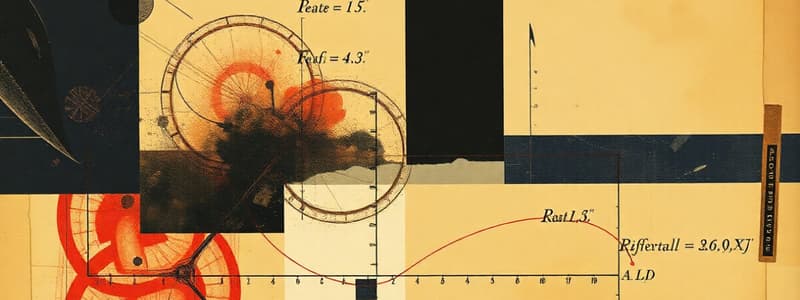Podcast
Questions and Answers
Four cyclists (Guillermo, Enrique, Pedro, and Luis) are participating in a race covering 20 km. At a specific moment, Luis has covered $\frac{6}{11}$ of the race. How far has Luis traveled at that moment?
Four cyclists (Guillermo, Enrique, Pedro, and Luis) are participating in a race covering 20 km. At a specific moment, Luis has covered $\frac{6}{11}$ of the race. How far has Luis traveled at that moment?
- Approximately 9.1 km
- Approximately 10.9 km (correct)
- Approximately 11.5 km
- Approximately 12.2 km
Guillermo has completed $\frac{5}{8}$ of a 20 km cycling race. How many kilometers has Guillermo biked?
Guillermo has completed $\frac{5}{8}$ of a 20 km cycling race. How many kilometers has Guillermo biked?
- 12.5 km (correct)
- 8 km
- 15 km
- 10 km
In a cycling race, Enrique has completed $\frac{3}{5}$ of the distance he has left to travel. If the total race distance is 20 km, how far has Enrique cycled?
In a cycling race, Enrique has completed $\frac{3}{5}$ of the distance he has left to travel. If the total race distance is 20 km, how far has Enrique cycled?
- 5 km
- 12.5 km
- 7.5 km (correct)
- 10 km
Pedro is positioned exactly halfway between Guillermo and Enrique in a cycling race. If Guillermo has traveled 12.5 km and Enrique has traveled 7.5 km, what distance has Pedro covered?
Pedro is positioned exactly halfway between Guillermo and Enrique in a cycling race. If Guillermo has traveled 12.5 km and Enrique has traveled 7.5 km, what distance has Pedro covered?
Four cyclists are in a race. Luis has completed $\frac{6}{11}$ of the course, Guillermo $\frac{5}{8}$, and Enrique $\frac{3}{5}$ of his remaining distance. If Pedro is midway between Guillermo and Enrique, who is currently in the lead?
Four cyclists are in a race. Luis has completed $\frac{6}{11}$ of the course, Guillermo $\frac{5}{8}$, and Enrique $\frac{3}{5}$ of his remaining distance. If Pedro is midway between Guillermo and Enrique, who is currently in the lead?
During a race, Luis has covered $\frac{6}{11}$ of the total distance. What fraction of the race remains for Luis to complete?
During a race, Luis has covered $\frac{6}{11}$ of the total distance. What fraction of the race remains for Luis to complete?
Guillermo has completed $\frac{5}{8}$ of a race. What fraction remains for him to complete?
Guillermo has completed $\frac{5}{8}$ of a race. What fraction remains for him to complete?
In the cycling race, Enrique has traveled 7.5 km. What fraction of the 20 km race does this represent?
In the cycling race, Enrique has traveled 7.5 km. What fraction of the 20 km race does this represent?
Pedro is at the midpoint between Guillermo and Enrique. Guillermo has completed $\frac{5}{8}$ of the race, and Enrique has completed $\frac{3}{8}$. What fraction of the race has Pedro completed?
Pedro is at the midpoint between Guillermo and Enrique. Guillermo has completed $\frac{5}{8}$ of the race, and Enrique has completed $\frac{3}{8}$. What fraction of the race has Pedro completed?
What information is most crucial to determine the cyclists' order in the race?
What information is most crucial to determine the cyclists' order in the race?
Which strategy is the most suitable for solving this problem, given the different fractions of course completed?
Which strategy is the most suitable for solving this problem, given the different fractions of course completed?
The race organizers decide to shorten the 20 km course by 25%. If Luis has already completed $\frac{6}{11}$ of the original race, how much farther does he have to cycle in kilometers to finish the shortened race?
The race organizers decide to shorten the 20 km course by 25%. If Luis has already completed $\frac{6}{11}$ of the original race, how much farther does he have to cycle in kilometers to finish the shortened race?
Suppose the cyclists maintain their current speeds. Which cyclist will most likely finish the 20km race last?
Suppose the cyclists maintain their current speeds. Which cyclist will most likely finish the 20km race last?
If the cyclists stop for a 15-minute break, and then continue at the same speeds, how would it affect their finishing order?
If the cyclists stop for a 15-minute break, and then continue at the same speeds, how would it affect their finishing order?
The cyclists decide to form teams of two. Which pairing would result in the team having covered the greatest combined distance at the measured moment?
The cyclists decide to form teams of two. Which pairing would result in the team having covered the greatest combined distance at the measured moment?
If the race's primary purpose is to promote municipal cycling, and not competition, which cyclist's current position best embodies the spirit of community involvement?
If the race's primary purpose is to promote municipal cycling, and not competition, which cyclist's current position best embodies the spirit of community involvement?
What is a reasonable assumption that might be made to simplify solving the problem of how the race progresses?
What is a reasonable assumption that might be made to simplify solving the problem of how the race progresses?
Suppose the distance to the finish line is re-scaled such that the total race now represents '1'. How would Guillermo's current position be represented?
Suppose the distance to the finish line is re-scaled such that the total race now represents '1'. How would Guillermo's current position be represented?
If Pedro decides to wait for Enrique to catch up before continuing, what essential change to the problem does this introduce?
If Pedro decides to wait for Enrique to catch up before continuing, what essential change to the problem does this introduce?
A local newspaper reports that Luis is in the lead by a 'significant margin'. Which statement provides the most appropriate qualitative analysis of the accuracy of the newspaper's claim?
A local newspaper reports that Luis is in the lead by a 'significant margin'. Which statement provides the most appropriate qualitative analysis of the accuracy of the newspaper's claim?
Flashcards
Cycling Race Description
Cycling Race Description
Four friends (Guillermo, Enrique, Pedro, and Luis) are participating in a cycling race organized by the municipality.
Distances Covered
Distances Covered
Luis has covered 6/11 of the route, Guillermo has covered 5/8 of the route, and Enrique has covered 3/5 of the remaining distance to the finish line.
Pedro's Position
Pedro's Position
Pedro is at an equal distance between Guillermo and Enrique.
Race Length
Race Length
Signup and view all the flashcards
Enrique's Distance
Enrique's Distance
Signup and view all the flashcards
Distance Traveled by Luis
Distance Traveled by Luis
Signup and view all the flashcards
Distance Traveled by Guillermo
Distance Traveled by Guillermo
Signup and view all the flashcards
Racer Order
Racer Order
Signup and view all the flashcards
Study Notes
Introduction to the Diffusion Equation
- The time-dependent heat equation, also known as the diffusion equation, is expressed as $\frac{\partial u}{\partial t} = \Delta u$ in $\Omega \times (0, T]$.
- $\Omega$ is an open set in $\mathbb{R}^n$, and $0 < T < \infty$.
- Diffusion describes how a substance spreads out over time until evenly distributed.
- Example: A drop of ink in still water.
Initial and Boundary Conditions
- Solving the diffusion equation requires initial and boundary conditions.
- The initial condition prescribes the temperature distribution at time $t = 0$ as $u(x, 0) = g(x)$ for $x \in \Omega$.
- $g: \Omega \rightarrow \mathbb{R}$ is a given function.
- The Dirichlet boundary condition prescribes the temperature on the boundary of $\Omega$ as $u(x, t) = h(x, t)$ for $x \in \partial \Omega, t > 0$.
- $h: \partial \Omega \times (0, T] \rightarrow \mathbb{R}$ is a given function.
- The Neumann boundary condition prescribes the heat flux on the boundary of $\Omega$ as $\frac{\partial u}{\partial n}(x, t) = h(x, t)$ for $x \in \partial \Omega, t > 0$.
- $h: \partial \Omega \times (0, T] \rightarrow \mathbb{R}$ is a given function.
The Maximum Principle
- There's a maximum principle similar to the Laplace equation for the heat equation.
- $\Omega_T = \Omega \times (0, T]$, and $\Gamma_T = \overline{\Omega_T} \setminus \Omega_T$.
- $\Gamma_T$ is the parabolic boundary of $\Omega_T$.
- Theorem: If $u \in C^{2, 1}(\Omega_T) \cap C(\overline{\Omega_T})$ satisfies the heat equation, then $\max_{\overline{\Omega_T}} u = \max_{\Gamma_T} u$.
- Proof idea: If the maximum is in the interior of $\Omega_T$ at $(x_0, t_0)$, derivatives imply $\Delta u(x_0, t_0) \leq 0$ contradicting the heat equation.
- Corollary: If $u \in C^{2, 1}(\Omega_T) \cap C(\overline{\Omega_T})$ satisfies the heat equation and $u = 0$ on $\Gamma_T$, then $u = 0$ in $\overline{\Omega_T}$.
- Corollary: If $u, v \in C^{2, 1}(\Omega_T) \cap C(\overline{\Omega_T})$ satisfy the heat equation and $u = v$ on $\Gamma_T$, then $u = v$ in $\overline{\Omega_T}$.
Energy Estimates
- Let $u$ be a solution of the heat equation with Dirichlet boundary condition.
- The energy of $u$ is defined as $E(t) = \frac{1}{2} \int_{\Omega} u(x, t)^2 dx$.
- The rate of change of energy is $\frac{d}{dt} E(t) = \int_{\Omega} u(x, t) \frac{\partial u}{\partial t}(x, t) dx = \int_{\Omega} u(x, t) \Delta u(x, t) dx$.
- Using integration by parts, $\int_{\Omega} u \Delta u dx = - \int_{\Omega} |\nabla u|^2 dx + \int_{\partial \Omega} u \frac{\partial u}{\partial n} dS$.
- Since $u = 0$ on $\partial \Omega$, $\frac{d}{dt} E(t) = - \int_{\Omega} |\nabla u|^2 dx \leq 0$.
- Thus, the energy is decreasing in time, consistent with the second law of thermodynamics.
Studying That Suits You
Use AI to generate personalized quizzes and flashcards to suit your learning preferences.




